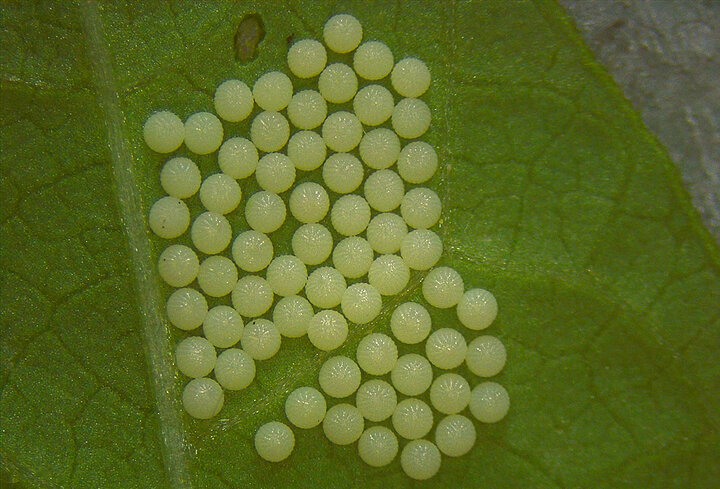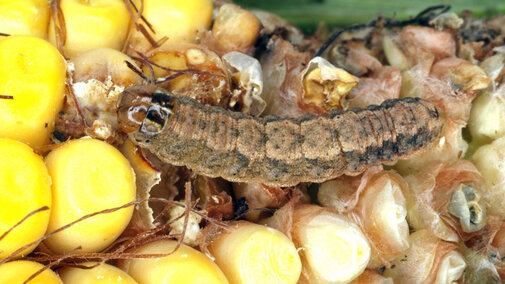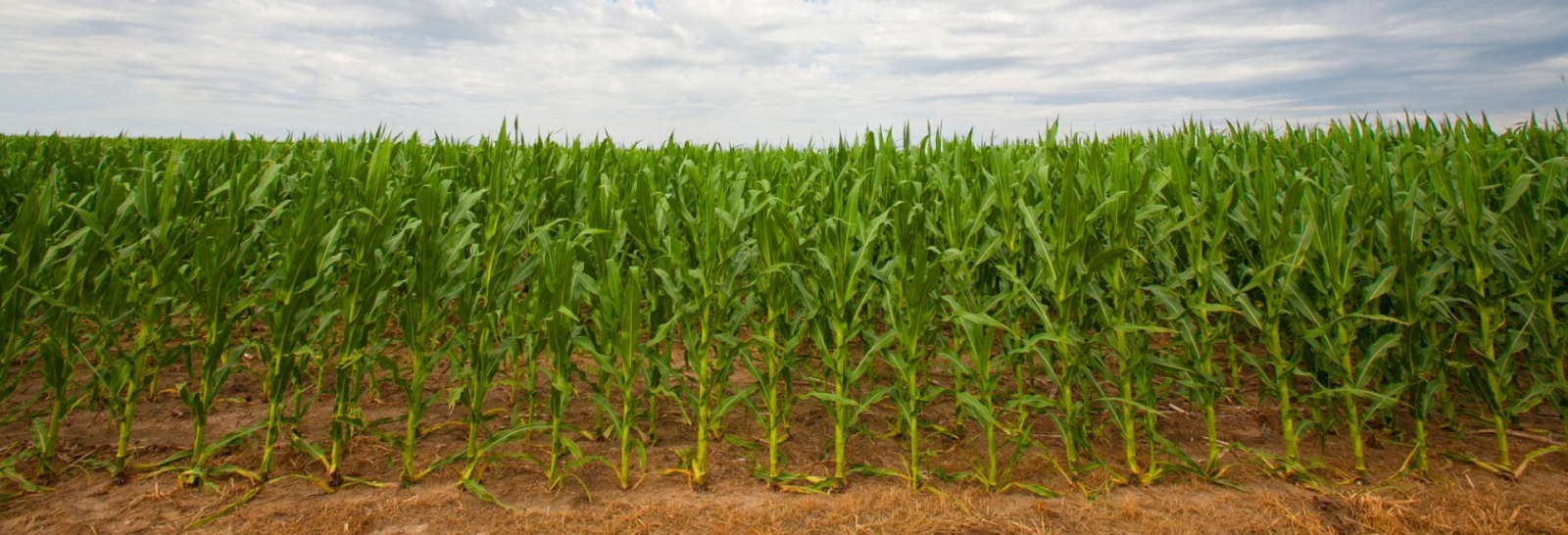The very first western bean cutworm (WBC) moths have been reported from eastern locations in Nebraska. It is time to start thinking about scheduling for scouting for this important pest of corn and dry beans. WBC moths prefer to lay their eggs on corn plants when they are approaching tassel emergence, as the tassel is the preferred food source for newly hatched WBC larvae. A match between the flight of the moths and the late whorl to early tassel stage of corn can result in high levels of infestation.
Predicted Dates of WBC Flight for Nebraska in 2025
Overall, the estimated dates for WBC flights in 2025 are slightly earlier than those from 2022-2024. Earliest flights will be observed in eastern Nebraska, such as Lincoln and Grand Island, while the latest flights will be recorded in the Panhandle, such as Sidney and Alliance, NE (Table 1).
Municipality | Coordinates | Elev. | 5% | 10% | 25% | 50% | 75% | 90% | 95% | |
|---|---|---|---|---|---|---|---|---|---|---|
Alliance, NE | 42.17 -102.93 | 4072 | 18-Jul | 20-Jul | 25-Jul | 28-Jul | 31-Aug | 4-Aug | 7-Aug | |
Ainsworth, NE | 42.57 -99.83 | 2500 | 6-Jul | 9-Jul | 13-Jul | 16-Jul | 20-Jul | 23-Jul | 26-Jul | |
Arthur, NE | 41.45 -101.72 | 3589 | 10-Jul | 13-Jul | 16-Jul | 19-Jul | 23-Jul | 27-Jul | 29-Jul | |
Clay Center, NE | 40.52 -98.05 | 1788 | 1-Jul | 4-Jul | 7-Jul | 10-Jul | 14-Jul | 18-Jul | 20-Jul | |
Columbus, NE | 41.46 -97.33 | 1450 | 30-Jun | 2-Jul | 5-Jul | 8-Jul | 12-Jul | 16-Jul | 18-Jul | |
Concord, NE | 42.38 -96.97 | 1545 | 2-Jul | 4-Jul | 8-Jul | 11-Jul | 15-Jul | 19-Jul | 22-Jul | |
Gothenburg, NE | 40.95 -100.20 | 2628 | 2-Jul | 4-Jul | 7-Jul | 11-Jul | 15-Jul | 18-Jul | 21-Jul | |
Grand Island, NE | 40.96, -98.31 | 1843 | 30-Jun | 2-Jul | 5-Jul | 8-Jul | 12-Jul | 16-Jul | 19-Jul | |
Hayes Center, NE | 40.55 -101.03 | 3064 | 6-Jul | 8-Jul | 11-Jul | 15-Jul | 18-Jul | 22-Jul | 25-Jul | |
Holdrege, NE | 40.5 -99.37 | 2323 | 3-Jul | 5-Jul | 8-Jul | 12-Jul | 17-Jul | 19-Jul | 22-Jul | |
Imperial, NE | 40.50, -101.65 | 3294 | 6-Jul | 8-Jul | 12-Jul | 15-Jul | 19-Jul | 22-Jul | 25-Jul | |
Kearney, NE | 40.72 -99.02 | 2129 | 2-Jul | 4-Jul | 8-Jul | 11-Jul | 15-Jul | 18-Jul | 21-Jul | |
Lincoln, NE | 40.84, -96.76 | 1170 | 25-Jun | 27-Jun | 30-Jun | 4-Jul | 7-Jul | 11-Jul | 14-Jul | |
North Platte, NE | 41.08 -100.78 | 2841 | 7-Jul | 9-Jul | 13-Jul | 16-Jul | 20-Jul | 23-Jul | 26-Jul | |
Ogallala, NE | 41.12 -101.72 | 3230 | 7-Jul | 9-Jul | 12-Jul | 16-Jul | 19-Jul | 23-Jul | 26-Jul | |
Scottsbluff, NE | 41.88 -103.68 | 3934 | 7-Jul | 9-Jul | 12-Jul | 16-Jul | 19-Jul | 23-Jul | 26-Jul | |
Sidney, NE | 41.22 -103.03 | 4331 | 16-Jul | 18-Jul | 21-Jul | 25-Jul | 29-Jul | 2-JAug | 5-Aug | |
York, NE | 40.87 -97.63 | 1637 | 1-Jul | 3-Jul | 6-Jul | 9-Jul | 13-Jul | 17-Jul | 20-Jul | |
To produce the table above, recorded temperatures were taken from the High Plains Regional Climate Center (HPRCC) from March 1 to approximately June 17-20. A long-term (1991-2020) average was used in order to predict the average temperature for later dates.
Another option for seeing moth flight predictions in your area is to use UNL’s AgriTools mobile app for Apple or Android, which will provide predictions similar to the table below by pulling temperature data from weather stations around your location.
Introduction to Insect Degree-day Models
The importance of knowing when an insect pest will cause damage in a field is essential to producers and crop consultants when making management decisions. Since insect development is greatly affected by temperature, the timing of insect emergence can be estimated accurately by using a combination of calendar dates and assessment of temperature variations from year to year.
The use of a degree-day model can help provide producers with accurate data. Degree-days measure the amount of heat between upper and lower thresholds to which an insect has been exposed. A model for the western bean cutworm (WBC) has been developed through the collaboration of entomologists from the University of Minnesota and the University of Nebraska.
Each degree-day model is different, but most models will subtract the lower threshold from the average temperature for each day. For example, in the model developed for WBC, if a certain day had a low of 55°F and a high of 65°F, and the model has a lower threshold of 38°F and an upper threshold of 75°F, then the degree-days would be calculated as:
[(65+55)/2]-38
[120/2]-38 = 22°F degree-days
Note: If the average temperature is less than the lower threshold (38°F), then you should use the lower threshold as the average temperature. If the average temperature is greater than the upper threshold (75°F), then you should use the upper threshold prior to subtracting the lower threshold.
Western Bean Cutworm Degree-day Model
Entomologists from the University of Nebraska-Lincoln (Tom Hunt and Robert Wright), and the University of Minnesota (Roger Moon, Bill Hutchison, and Anthony Hanson) developed the most recent degree-day model. The lower threshold is 38°F, while the upper threshold is 75°F beginning on March 1. Once 2,577 degree-days Fahrenheit is reached, 25% of the WBC flight occurs and scouting of corn fields should begin. (Pheromone trapping in dry bean fields should begin the last week of June before any WBC have emerged.)
If an insecticide application is warranted, it should be made 10-21 days after peak flight in dry bean and when 95% of plants have tasseled in corn. For more information, see NebGuide G2013 by Seymour et al. 2010.
°Days F (±95% Confidence Interval) | % WBC Flight |
|---|---|
| 2,377 (1,843 - 3,066) | 5 |
| 2,456 (2,147 - 2,809) | 10 |
| 2,577 (2,416 - 2,749) | 25 |
| 2,704 (2,577 - 2,838) | 50 |
| 2,838 (2,660 - 3,027) | 75 |
| 2,977 (2,603 - 3,046) | 90 |
| 3,077 (2,385 - 3,968) | 95 |
Scouting and Management of Western Bean Cutworm
WBC eggs can be found on the upper surfaces of corn leaves, and the lower surfaces of dry bean leaves. Eggs are found in masses ranging from 5-200, with an average of 50-85. When first laid, the eggs will be white and gradually darken during the four- to six-day development (Figure 1). Freshly hatched larvae will first eat the eggshells before consuming the host plant (Figure 2 and 3).
Older larvae can be identified by two dark-colored rectangular spots directly behind their head (Figure 3). Adult moths are identifiable by a white band on the anterior margin on the forewing followed by a white circle halfway down the wing and a white crescent located two-thirds down the wing (Figure 4). WBC moths are about three-fourths of an inch long by 1.5
inches wide.




It is more challenging to scout for WBC in dry bean fields due to dense and robust bean canopy. However, pheromone traps (two to four green, bucket-style traps or milk jug traps per field with monthly pheromone replacements) can be used to provide an estimate of a possible infestation and should be installed prior to the predicted 5% flight date.
Nominal action thresholds for dry bean fields can be calculated using the average, cumulative trap capture for a field. If fewer than 700 moths are caught up to peak, there is low risk; if more than 700 but fewer than 1,000 moths are caught, then there is moderate risk; and if there are more than 1,000 moths caught, then the risk is high. However, note that pheromone traps only capture male moths and other local conditions may contribute to larval success and corresponding damage from WBC in any given field.
Other Available Resources
- Western bean cutworm speed scouting app for Apple or Android.
- Western bean cutworm Speed Scout spreadsheet.
- Light trap reports for Clay Center, Mead, Concord, and North Platte.
- Western Bean Cutworm Central website

